Side Menu:
First Officer Murdoch: R.M.S.Titanic
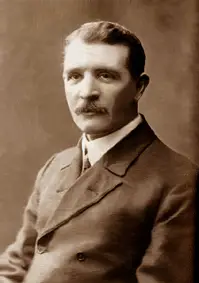
William Murdoch in his 30s.
(Click image to enlarge)
Thirty-nine year-old William McMaster Murdoch, with an "ordinary master's certificate" and a reputation as a "canny and dependable man" (3.) had climbed through the ranks of the White Star Line to become one of its foremost senior officers. It was only natural that he was selected to be Titanic's Chief Officer, with sixteen years of maritime experience now behind him.
Demotion and a maiden voyage
By the end of March, 1912, Titanic's construction and fitting-out drew to a close. On the 24th of March, 1912, William Murdoch signed on as Chief Officer of the Titanic in Belfast, along with the other senior officers, Lightoller and Blair, as it is readied for her sea trials and delivery trip to Southampton. This was the day before Captain Herbert Haddock joined as master, according to Titanic's 'Particulars of Engagement' in Belfast. The crew then began to gather for her sea trials:
"The junior officers Pitman, Boxhall, Lowe and Moody received telegrams from the White Star Line marine superintendent to report to the company's Liverpool office at 9am on 26 March to pick up their tickets for Belfast. Departing from Liverpool at 10 o'clock that night they arrived at Belfast and joined Titanic at about 12 noon on 27 March, reporting on board to Chief Officer William Murdoch."(7.)

Titanic's Particulars of Engagement in Belfast lists Murdoch as Chief Officer.(Image: Public Record Office/Nicola Foster). (Click image to enlarge)
Sea trials began on April 2nd. in the Belfast Lough and lasted for less than a day.
"Following lunch, the major stopping test was conducted. A buoy was dropped in the waters of the Lough and, after turning, Titanic was put at full speed and, when precisely alongside the buoy, put at full astern. Officers Moody and Murdoch, sextants ready, carefully observed the buoy's position and the vessel's approach. They relayed their observations to Edward Wilding, who signaled Captain Smith. At the captain's command, the telegraph handle was quickly put to full astern. The entire vessel shuddered as the stress of full speed astern was imposed on her hull. At a twenty-knot speed, Titanic took a bit less than half a mile -about 850 yards- to come to a complete stop." (7.)
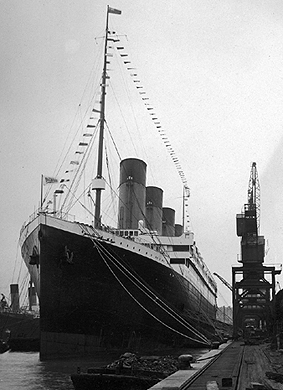
Titanic dressed in flags for Good Friday
(April 5, 1912) in Southampton.
(Click image to enlarge)
In later testimony at the British Board of Trade Inquiry into the Titanic disaster, Fifth Officer Harold Godfrey Lowe was "instructed by Mr. Murdoch, the then Chief Officer of the ship" to, in the words of the Commissioner, "look at the boats at Belfast and see that they were all there". With all tests meeting the Board of Trade standards, the Titanic sailed that very night at 8pm destined for Southampton, her port of embarkation, arriving on April 3rd. to begin provisioning and staffing for her maiden voyage. Then, a few days before sailing day, there was a surprising announcement. At the last moment, Captain Smith reshuffled the senior crew's positions to accommodate Henry Tingle Wilde as Chief Officer (as he had been aboard Olympic). This meant that Murdoch was bumped down to the position of First Officer, and Charles Herbert Lightoller to Second Officer, while David Blair was left out entirely, the other officers remaining the same.
One can only imagine Murdoch's disappointment at his demotion. In a letter to his sister "Peg" (9 years younger than him) written on April 8th, 1912, two days before sailing, while his wife Ada was taken on a tour of the new ship, he writes:
"I am still Chief Offr [Officer] until sailing day & then it looks as though I will have to step back, [to First Officer] so I am hoping that it will not be for long. The head Marine Supt. [Superintendent] from L'pool [Liverpool] seemed to be very favourably impressed & satisfied that everything went on A.1 [OK] & as much as promised that when Wilde goes I am to go up again."(1.).

This crew document shows the officer reshuffle.
Murdoch's demotion also meant a decrease in salary, from £25 back to £17. According to Elizabeth Gibbons Murdoch was in no urgent need of money and "would in fact leave his wife a respectable sum -- a spendthrift Scot is an oxymoron -- but the loss of an £8 raise to a married man with household expenses and a mortgage is no happy event at any time. It was particularly unwelcome in 1912, an age of iniquitous inflation and static wages that would last until the outbreak of the Great War." (55.)
In his book Titanic and Other Ships Lightoller describes the reshuffle:
"Unfortunately, whilst in Southampton, we had a re-shuffle amongst the Senior Officers. Owing to the Olympic being laid up, the ruling lights of the White Star Line thought it would be a good plan to send the Chief Officer of the Olympic, just for the one voyage, as Chief Officer of the Titanic, to help, with his experience of her sister ship. This doubtful policy threw both Murdoch and me out of our stride; and, apart from the disappointment of having to step back in our rank, caused quite a little confusion. Murdoch, from Chief, took over my duties as First, I stepped back on Blair’s toes as Second, and picked up the many threads of his job, whilst he,--luckily for him as it turned out—was left behind. The other officers remained the same. However, a couple of days in Southampton saw each of us settled in our new positions and familiar with our duties." (47.)
Elizabeth Gibbons notes "Lightoller's resentment at this demotion is palpable to anyone reading his memoirs; evidently blaming Wilde, his dislike for the man went straight through the grave and kept on going, and in 1935 was as fresh as the April day when Henry Wilde caused Charles Lightoller to lose rank." (55.)
There have been some who have speculated that the demotion was due to a lack of confidence Smith had in Murdoch. However evidence suggests that the demotion was primarily due to the White Star Line making use of Wilde who was waiting for his own promotion to captain of a White Star vessel. In Lightoller's article from the Christian Science Sentinel (December 1912) this is referenced when he writes:
"Shortly before we sailed from Southampton, Wilde, who was formerly chief of the Olympic, and who was to have been given command of another of the White Star steamers, which, owing to the coal strike and other reasons was laid up, was sent for the time being to the Titanic as chief, Murdoch ranking back to first, myself to second, and Blair standing out for the voyage." Christian Science Sentinel (December 1912)
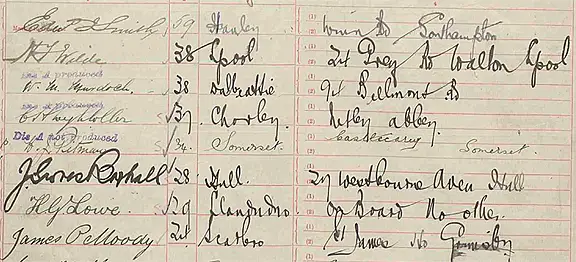
Titanic's Crew Agreement document, with the signatures of Captain Smith and his officers, courtesy of National Archives, UK.
Additionally a letter from David Blair, originally assigned as Titanic's Second officer, dated 4th of April 1912 mentions "I shall have to step out to make room for [the] Chief officer of the Olympic who was going in command but so many ships laid up he will have to wait..." (On a Sea of Glass, p.58 (54.)). However the letter makes it unclear whether Blair was referring to Wilde being captain of the Olympic or whether it was another ship, which is more likely. A Mr Smith, a manager of a New York club for mercantile mariners, wrote in April 1912 saying that Wilde "would have been Captain of the Cymric two trips ago, only the coal strike and the tying up of some of the ships altered the company's plans." ("Portbrush letter" by Senan Molony (8.))
On April 9th, Board of Trade Emigration Officer Maurice Clarke boards Titanic. He is assisted by Lightoller and Murdoch for many hours as he carefully checks to make sure that Titanic meets safety requirements.
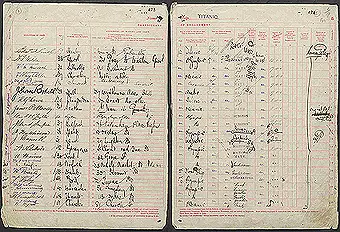
Titanic's Crew Agreement document, including the
signatures of Captain Smith and his officers, courtesy of
National Archives, UK. (Click image to enlarge)
Depature Day and Near Disaster
According to Robert Hichens, Titanic's quartermaster, William Murdoch called out the names of the crew on the day of muster in Southampton. (Board of Trade Enquiry, 7 May, 1912) The new Chief Officer, Henry Tingle Wilde, arrived aboard ship sometime on the 9th of April, after coaling, crew recruitment, cargo loading and loading of food supplies had already taken place. Author J. Kent Layton in his book On A Sea of Glass: The Life & Loss of the RMS Titanic, Lightoller (and also most likely Murdoch) do not have time to change their uniform rank insignia before the voyage (as seen in a photograph taken on 11 April), causing later confusion among crew and passengers alike. Consequently, on sailing day, April 10th, 1912, when Titanic began her maiden voyage, Murdoch, now First Officer, found himself in his old position on the stern, as he had been on the Olympic. Historians Charles Haas and John Eaton describe the scene:
"The senior officers Wilde, Murdoch and Lightoller- submitted their reports to the Master First Officer Murdoch reported the vessel ready to sail: boatswain's parties were fully manned and standing by the moorings. First Officer Murdoch was at the stern, overseeing the handling by the boatswain's mate and his men of the mooring lines and tugboat hawsers there. Third Officer Pitman, on the docking bridge, passed along instructions to Murdoch in response to the bridge's telegraphed orders." (7.)
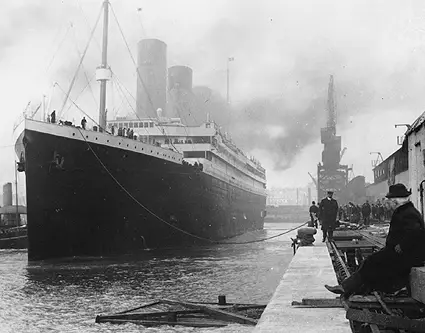
Titanic departing Southampton docks.
(Click image to enlarge)
Just as aboard Olympic, Murdoch also witnessed the powerful effect of these new, large luxury liners. As the Titanic steamed along the River Test, the water displacement caused all six mooring ropes on the New York to break and her stern to swing toward Titanic. Quick action averted a collision by only four feet. Murdoch later writes in a letter:
"As we were leaving Southampton & passing the Oceanic & New York which were moored alongside each other, they ranged so much that the New York broke adrift & it was only very narrowly that we escaped doing both she and ourselves serious damage, however we did not touch her & I don't think either New York or Oceanic has any damage at all."(1.)
To Murdoch, it must have been a serious case of deja vu. However, it was sadly only a foretaste of what was to come.
Curious Incident in Cherbourg
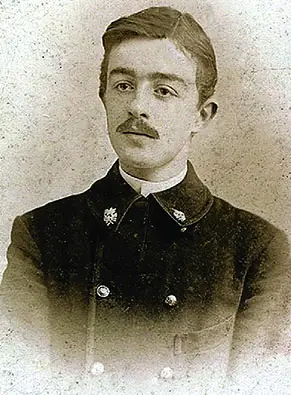
Jules Munsch: "Lieutenant Murdock
disobeyed a major maritime regulation"
Although the near collision delayed departure for about an hour while the drifting New York was brought under control, the Titanic arrived four hours later at 6.35pm in the French port of Cherbourg. Due to the size of Titanic and the lack of suitable docking facilities at Cherbourg the White Star Line operating two tenders -the SS Traffic and the SS Nomadic. Within 90 minutes 274 passengers boarded Titanic and 24 departed aboard the tenders.
It was on the tender Traffic, that a 'curious incident' involving Murdoch allegedly took place. According to a young French man by the name of Jules Munsch (1893-1915) who wrote a May 1912 account in Les Cahiers de l’Ecole Nationale de Rouen and only recently released in April 2012, First Officer Murdoch prohibited a French Naval officer Commander Leloup who was aboard the Traffic from temporarily boarding Titanic, an order that was subsequently overridden by Captain Smith and lead to Munsch and Leloup having a personal tour of Titanic. A translation of his account is as follows:
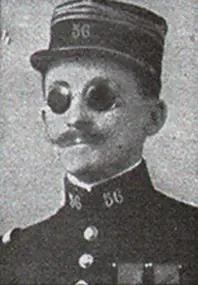
French Naval officer Commander
Leloup who Murdoch allegedly
prohibited from boarding the Titanic
at Cherbourg
"Then began the transhipment of passengers and baggage. The Nomadic, docked in port, carrying the first and second classes passengers. Aboard the Traffic, a curious little incident occurred. Commander Leloup, French Navy military, wanted to take the Nomadic to paid a visit on the Titanic. Having missed the departure, he embarked aboard the Traffic and wanted to cross the gangplank. Murdock refused, and Leloupe asked: "Is the Captain of the Traffic on board?" We sent for Gaillard who introduced himself: "At your orders, sir!" Leloup: " I want to know why a French naval officer is denied boarding of a foreign merchant ship in the harbor of Cherbourg?" Indeed, Lieutenant Murdock disobeyed a major maritime regulation by prohibiting a French officer access to the ship. Captain Smith was called and came himself to fetch Commander Leloup at the gangplank. We followed them eagerly, and took advantage of the honors of the gateway." (account courtesy of Tiphaine Hirou for the full account please see here)
Queenstown and the Lifeboat List
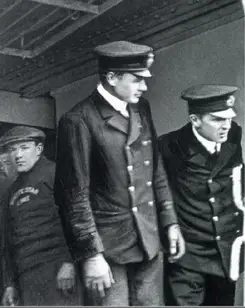
Lightoller and Murdoch (right) prepare to
close the gangway before departure from
Queenstown, Ireland, April 11th, 1912.
It is the last photograph of Murdoch or
any Titanic officer ever seen on duty.
(Click image to enlarge)
Finally at 8:10 p.m Titanic departed Cherbourg bound for Queenstown, arriving at 11.30 am on Thursday 11 April at Cork Harbour on the south coast of Ireland. Once again the docking facilities were not sufficient for a ship the size of Titanic and tenders were used to bring 113 third class and seven second class passengers came aboard, while seven passengers departed.
It here the last known photograph of Titanic's crew was taken as Lightoller and Murdoch prepare to close the gangway before departure from Queenstown It is the last photograph of Murdoch or any Titanic officer ever seen on duty.
It is interesting to note that this photograph reveals that Lightoller is apparently still wearing his first officer's stripes (two stripes), which would also indicate although not clearly seen in the image that Murdoch would be wearing his Chief Officer's stripes (three stripes). It leads to the very real possibility that although their ranks had changed due to the last minute deck department reshuffle, their uniforms had not, which would explain later confusions involving Murdoch still being called the 'chief officer'.
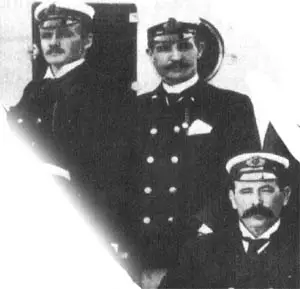
Lightoller, Murdoch and McGiffin as shipmates
aboard the Medic in 1900.
And as Captain James McGiffin was the superintendent of Queenstown and he paid a visit on board the Titanic to salute his former shipmates and friends Lightoller and Murdoch during their stop there, it is tantalizing to think that this photograph depicts Lightoller and Murdoch bidding McGiffin farwell as he leaves Titanic on a tender.
Titanic weighed anchor for the last time at 1.30 pm and departed Queenstown on her westward journey across the Atlantic. Soon after their departure, Murdoch was, according to Fifth Officer Lowe, in charge of making out a lifeboat list which indicated which men to be stationed at which boat.
After leaving Queenstown, Mr. Murdoch, the first officer, made out a boat list, stationing the men at their different positions at the boats, and there was an emergency boat list made out as well. I cannot say definitely whether either or both of these lists were posted in the forecastle. I do not now remember to what boat I had been assigned on this list. The general boat list passed through my hands in being sent to the captain for approval. I glanced at this list casually, and remember from this glance that there were three seamen assigned to some of the boats and four to others. (The Deposition of Harold Godfrey Lowe, before the British Consulate General, In New York, May 1912)
Senior Officers’ Watches:
|
Second Officer Lightoller: |
6 am to 10 am |
6 pm to 10 pm |
|
First Officer Murdoch: |
10 am to 2 pm |
10 pm to 2 am |
|
Chief Officer Wilde: |
2 am to 6 am |
2 pm to 6 pm |
This schedule also allowed time for eating, as explained by Lightoller during the British Inquiry: "Lunch is at half-past 12. I relieve the First Officer, who has his lunch at half-past 12, and he comes on deck again about 1 o’clock or five minutes past; then I have mine." Additionally, Murdoch went for dinner on April 14th at 6.30pm and then relieved Lightoller at 7.35pm.